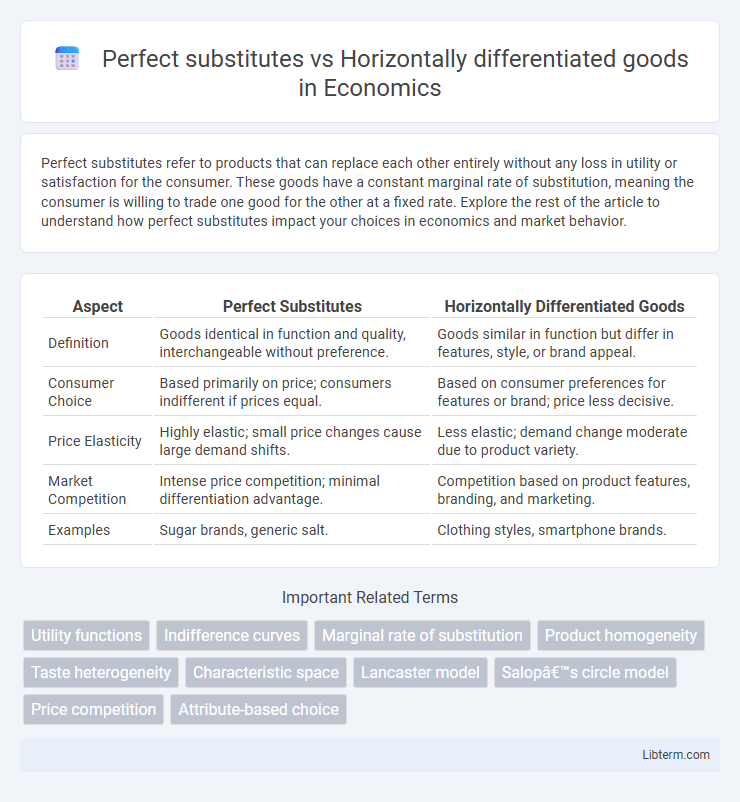Perfect substitutes refer to products that can replace each other entirely without any loss in utility or satisfaction for the consumer. These goods have a constant marginal rate of substitution, meaning the consumer is willing to trade one good for the other at a fixed rate. Explore the rest of the article to understand how perfect substitutes impact your choices in economics and market behavior.
Table of Comparison
| Aspect | Perfect Substitutes | Horizontally Differentiated Goods |
|---|---|---|
| Definition | Goods identical in function and quality, interchangeable without preference. | Goods similar in function but differ in features, style, or brand appeal. |
| Consumer Choice | Based primarily on price; consumers indifferent if prices equal. | Based on consumer preferences for features or brand; price less decisive. |
| Price Elasticity | Highly elastic; small price changes cause large demand shifts. | Less elastic; demand change moderate due to product variety. |
| Market Competition | Intense price competition; minimal differentiation advantage. | Competition based on product features, branding, and marketing. |
| Examples | Sugar brands, generic salt. | Clothing styles, smartphone brands. |
Understanding Perfect Substitutes
Perfect substitutes are products that consumers perceive as identical in quality and utility, leading to seamless interchangeability with no preference for one over another. This lack of differentiation results in identical pricing strategies and competitive markets where only price influences consumer choice. Understanding perfect substitutes helps in analyzing scenarios where brand loyalty is minimal and competition purely revolves around cost efficiency and availability.
Defining Horizontally Differentiated Goods
Horizontally differentiated goods are products that serve the same basic function but vary in attributes such as design, color, or flavor, appealing to different consumer preferences without implying a quality hierarchy. Unlike perfect substitutes, which are identical in every aspect and interchangeable, horizontally differentiated goods emphasize variety and consumer choice within the same category. This differentiation allows firms to compete on features other than price, fostering brand loyalty and segmented markets.
Key Characteristics of Perfect Substitutes
Perfect substitutes are defined by identical functional attributes, allowing consumers to switch between products without preference or perceived loss in utility. These goods possess uniform price points, quality, and performance, leading to complete interchangeability in consumption. The absence of brand loyalty or distinguishing features makes demand highly sensitive to price changes, resulting in perfectly elastic demand curves.
Features of Horizontally Differentiated Products
Horizontally differentiated products vary in attributes such as style, color, or flavor, catering to diverse consumer preferences despite having similar functional value. These goods create market segmentation by offering choices that differ qualitatively rather than quantitatively, unlike perfect substitutes which are identical in every aspect. Consumer preference for horizontally differentiated products depends largely on individual tastes rather than price or performance alone.
Consumer Preferences and Choice Behavior
Consumers choose perfect substitutes purely based on price and availability, exhibiting complete interchangeability with no preference for one over the other. Horizontally differentiated goods appeal to varying tastes and preferences, leading consumers to select based on subtle product attributes rather than price alone. This differentiation creates brand loyalty and consumer heterogeneity, influencing market segmentation and demand elasticity.
Market Structure Implications
Perfect substitutes create highly competitive markets characterized by price-driven competition and minimal product differentiation, leading to zero economic profits in the long run under perfect competition. Horizontally differentiated goods allow firms to maintain some market power by catering to diverse consumer preferences, resulting in monopolistic competition with downward-sloping demand curves and positive but limited economic profits. The presence of product differentiation in horizontal differentiation reduces price elasticity, enabling firms to avoid direct price wars prevalent in markets of perfect substitutes.
Price Sensitivity and Competition
Perfect substitutes exhibit extreme price sensitivity as consumers readily switch between nearly identical products, intensifying price competition among firms. Horizontally differentiated goods show less price sensitivity since variations in features or branding reduce direct price comparability and allow firms some pricing power. The competition among horizontally differentiated products centers more on non-price factors like quality, design, or brand identity rather than purely on price competition seen in perfect substitutes.
Real-World Examples of Both Types
Perfect substitutes, such as generic aspirin brands, provide identical utility with no price-based preference, leading consumers to choose solely on cost. Horizontally differentiated goods like smartphones illustrate variations in features and design without significant quality differences, allowing consumers to select based on personal taste. Companies like Coca-Cola and Pepsi exemplify horizontal differentiation through similar cola products distinguished by brand loyalty and flavor nuances.
Strategic Positioning for Businesses
Strategic positioning for businesses offering perfect substitutes involves competing primarily on price and efficiency to capture market share since products are identical in consumer perception. Conversely, firms dealing with horizontally differentiated goods emphasize unique features, brand identity, or customer experience to create perceived value and reduce direct price competition. This differentiation allows businesses to target specific customer segments, enhancing loyalty and enabling greater control over pricing strategies.
Economic Outcomes and Welfare Effects
Perfect substitutes create intense price competition, driving prices down to marginal cost, which maximizes consumer surplus but can erode producer profits. Horizontally differentiated goods allow firms to maintain some pricing power due to product uniqueness, leading to higher prices and variety, enhancing consumer welfare through increased choice. Economic outcomes in differentiated markets balance allocative efficiency with consumer preference heterogeneity, while perfect substitutes emphasize efficiency but risk reduced innovation incentives.
Perfect substitutes Infographic

 libterm.com
libterm.com